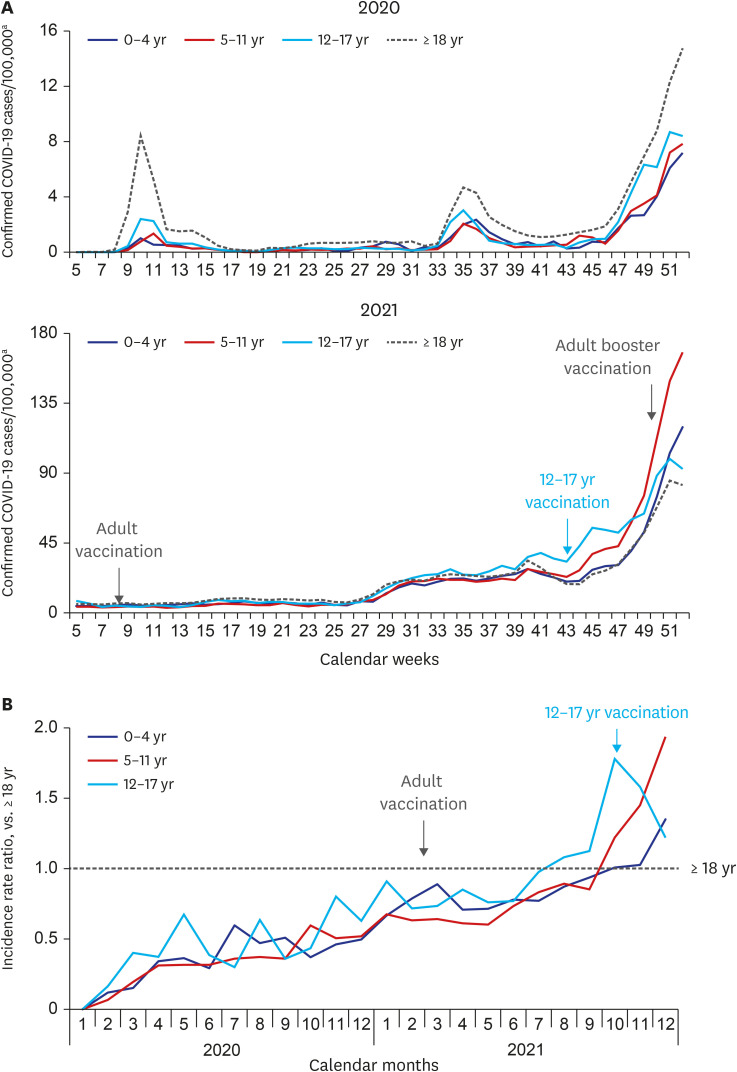J Korean Med Sci.
2022 May;37(17):e124. 10.3346/jkms.2022.37.e124.
Short Term Impact of Coronavirus Disease 2019 Vaccination in Children in Korea
- Affiliations
-
- 1Department of Pediatrics, Seoul National University Bundang Hospital, Seongnam, Korea
- 2Department of Pediatrics, Seoul National University College of Medicine, Seoul, Korea
- 3Department of Pediatrics, Seoul National University Children’s Hospital, Seoul, Korea
- 4Korea Disease Control and Prevention Agency, Cheongju, Korea
- 5Department of Pediatrics, Korea University Anam Hospital, Seoul, Korea
- KMID: 2529700
- DOI: http://doi.org/10.3346/jkms.2022.37.e124
Abstract
- Background
The epidemiology of coronavirus disease 2019 (COVID-19) has changed continuously throughout the pandemic.
Methods
We analyzed changes in the incidence of severe acute respiratory syndrome coronavirus 2 (SARS-CoV-2) infection according to the age group in South Korea from February 2020 to December 2021.
Results
Since the COVID-19 pandemic, the incidence among adults aged ≥ 18 years was higher than all the other age groups in 2020; however, a shift toward younger ages occurred in June 2021. In addition, we found significant changes in epidemiology after the introduction of SARS-CoV-2 vaccines in adults aged ≥ 18 and children 12–17 years. Until recently, children were not regarded as the drive for the pandemic; however, children aged 5–11 and 0–4 years had the highest incidence among all the age groups.
Conclusion
Therefore, policies for clinical support for an increase in COVID-19 cases among young children and age-specific preventive measures are needed.
Keyword
Figure
Reference
-
1. Boehmer TK, DeVies J, Caruso E, van Santen KL, Tang S, Black CL, et al. Changing age distribution of the COVID-19 pandemic - United States, May–August 2020. MMWR Morb Mortal Wkly Rep. 2020; 69(39):1404–1409. PMID: 33001872.2. Lopez Bernal J, Andrews N, Gower C, Robertson C, Stowe J, Tessier E, et al. Effectiveness of the Pfizer-BioNTech and Oxford-AstraZeneca vaccines on COVID-19 related symptoms, hospital admissions, and mortality in older adults in England: test negative case-control study. BMJ. 2021; 373:n1088. PMID: 33985964.3. Moline HL, Whitaker M, Deng L, Rhodes JC, Milucky J, Pham H, et al. Effectiveness of COVID-19 vaccines in preventing hospitalization among adults aged ≥65 Years - COVID-NET, 13 States, February–April 2021. MMWR Morb Mortal Wkly Rep. 2021; 70(32):1088–1093. PMID: 34383730.4. Choi MJ, Choi WS, Seong H, Choi JY, Kim JH, Kim YJ, et al. Developing a framework for pandemic COVID-19 vaccine allocation: a modified Delphi consensus study in Korea. J Korean Med Sci. 2021; 36(23):e166. PMID: 34128597.5. Choe YJ, Yi S, Hwang I, Kim J, Park YJ, Cho E, et al. Safety and effectiveness of BNT162b2 mRNA COVID-19 vaccine in adolescents. Vaccine. 2022; 40(5):691–694. PMID: 35012777.6. Woodworth KR, Moulia D, Collins JP, Hadler SC, Jones JM, Reddy SC, et al. The advisory committee on immunization practices’ interim recommendation for use of Pfizer-BioNTech COVID-19 vaccine in children aged 5–11 years - United States, November 2021. MMWR Morb Mortal Wkly Rep. 2021; 70(45):1579–1583. PMID: 34758012.7. Ministry of Health and Welfare of South Korea. Press release. Updated 2021. Accessed March 18, 2022. http://ncov.mohw.go.kr/tcmBoardView.do?brdId=3&brdGubun=31&dataGubun=&ncvContSeq=6242&board_id=312&contSeq=6242 .8. Siegel DA, Reses HE, Cool AJ, Shapiro CN, Hsu J, Boehmer TK, et al. Trends in COVID-19 cases, emergency department visits, and hospital admissions among children and adolescents aged 0–17 years - United States, August 2020-August 2021. MMWR Morb Mortal Wkly Rep. 2021; 70(36):1249–1254. PMID: 34499628.9. Elliott P, Haw D, Wang H, Eales O, Walters CE, Ainslie KEC, et al. Exponential growth, high prevalence of SARS-CoV-2, and vaccine effectiveness associated with the Delta variant. Science. 2021; 374(6574):eabl9551. PMID: 34726481.10. Choe YJ, Park YJ, Kim EY, Jo M, Cho EY, Lee H, et al. SARS-CoV-2 transmission in schools in Korea: nationwide cohort study. Arch Dis Child. 2022; 107(3):e20. PMID: 34857510.11. Chang TH, Wu JL, Chang LY. Clinical characteristics and diagnostic challenges of pediatric COVID-19: a systematic review and meta-analysis. J Formos Med Assoc. 2020; 119(5):982–989. PMID: 32307322.12. Han MS, Choi EH, Chang SH, Jin BL, Lee EJ, Kim BN, et al. Clinical characteristics and viral RNA detection in children with coronavirus disease 2019 in the Republic of Korea. JAMA Pediatr. 2021; 175(1):73–80. PMID: 32857112.13. Korea Disease Control and Prevention Agency. COVID-19 dashboard. Updated 2022. Accessed January 25, 2022. http://ncov.mohw.go.kr/ .14. Korea Disease Control and Prevention Agency. Press release. Updated 2022. Accessed March 18, 2022. http://ncov.mohw.go.kr/tcmBoardView.do?brdId=3&brdGubun=31&dataGubun=&ncvContSeq=6242&board_id=312&contSeq=6242 .15. Lee PI, Hu YL, Chen PY, Huang YC, Hsueh PR. Are children less susceptible to COVID-19? J Microbiol Immunol Infect. 2020; 53(3):371–372. PMID: 32147409.16. Lee H, Choi S, Park JY, Jo DS, Choi UY, Lee H, et al. Analysis of critical COVID-19 cases among children in Korea. J Korean Med Sci. 2022; 37(1):e13. PMID: 34981683.17. Lam-Hine T, McCurdy SA, Santora L, Duncan L, Corbett-Detig R, Kapusinszky B, et al. Outbreak associated with SARS-CoV-2 B.1.617.2 (Delta) variant in an elementary school - Marin County, California, May–June 2021. MMWR Morb Mortal Wkly Rep. 2021; 70(35):1214–1219. PMID: 34473683.
- Full Text Links
- Actions
-
Cited
- CITED
-
- Close
- Share
- Similar articles
-
- Latest Overseas Policy on Coronavirus Disease 2019 Vaccination for Children Aged 5 to 11
- Treatment for Immune Thrombocytopenia in Coronavirus Disease 2019 (COVID-19) Infection after COVID-19 Vaccination: A Case Report
- Treatment for Persistent Mass and Pain Lasting 4 Months Following Coronavirus Disease 2019 Vaccination: A Case Report
- Association between face covering policies and the incidence of coronavirus disease 2019 in European countries
- Understanding the impact on digestive disease in the post-COVID-19 condition: Editorial on “Long-term gastrointestinal and hepatobiliary outcomes of COVID-19: A multinational population-based cohort study from South Korea, Japan, and the UK”


